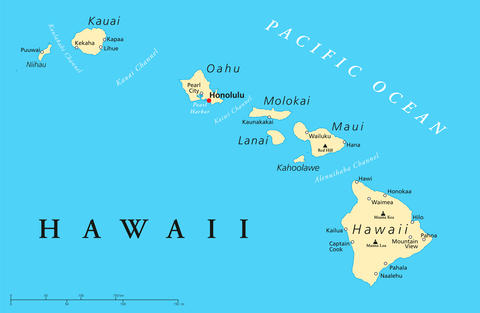Summary
The NIST U.S. Pacific Islands Program initiated FY 2010 is using the measurement and specimen banking expertise and capabilities of NIST personnel and facilities at the Hollings Marine Laboratory to help address environmental and ecological questions that are unique to the region. This program includes collaborations with NOAA, other Federal, State, local, and regional agencies, private organizations, universities, and research institutes to establish a biorepository in the region and to advance measurement capabilities for environmental health research.
Description

NIST collaborates with NOAA and State, local agencies, private organizations, universities, and research institutes to establish the infrastructure needed to advance measurement capabilities for environmental health research.
To help address environmental research and resource management in the Pacific Islands region, the 111th U.S. Congress directed NIST to "expand its capabilities and resources into the Pacific region through a Pacific Islands component of NIST" and included funding to "expand its biodiversity storage capabilities into the region."
The NIST Pacific Islands Program will improve biological and chemical measurement capabilities in the area of environment and health research, address future questions regarding the effects of human-induced and natural stressors (including climate change) on environmental conditions and marine animal/human health. This will be accomplished by enhancing the regional infrastructure for conducting such research, promoting interdisciplinary research, and establishing a collaborative link between the Pacific Islands region and NIST capabilities at its mainland campuses (Gaithersburg, MD and the HML in Charleston, SC), and contributing to the training of future scientists in the region.
Goals of the Program Include:
- Developing regional partnerships;
- Determining logistic requirements and developing logistical support;
- Identifying and complying with all permitting requirements for collecting, handling, and maintaining specimen collections;
- Working with regional partners to enhance measurement capabilities in the region through collaborations, training, and technology transfer.
Marine Mammal Health and Stranding Response Program (MMHSRP)
Expansion of the MMHSRP into the U.S. Pacific Islands region incorporates specimens collected from stranded animals into the NMMTB in the region. NIST works to establish baseline contaminant information including trace elements, organic contaminants, and emerging contaminants in marine mammal tissue collections from the region on species, that include spinner dolphin (Stenella longirostris), humpback whale (Megaptera novaeangliae), false killer whale (Pseudorca crassidens), melon-headed whale (Peponocephala electra), and Hawaiian monk seal (Neomonachus schauinslandi).
Seabird Tissue Archival and Monitoring Project (STAMP)
The Seabird Tissue Archival and Monitoring Project (STAMP) began as a collaborative effort between the US Fish and Wildlife Service Alaska Maritime National Wildlife Refuge (USFWS- AMNR) and NIST to monitor long-term trends in environmental quality. STAMP is an ongoing effort to track geographic and temporal trends in environmental quality and ensures chemical stability during long-term storage. The program analyzes subsamples of stored material to determine baseline levels of persistent bioaccumulative contaminants (e.g., chlorinated pesticides, polychlorinated biphenyls [PCBs], brominated flame retardants [polybrominated diphenyl ethers—PBDEs], butyltin compounds, and mercury). In 2010, the 111th Congress directed NIST to expand this and other programs into the U.S. Pacific Islands. The seabird egg collection is maintained in The NIST Biorepository at the Hollings Marine Laboratory.
Sea Turtle Health Assessment (BEMAST)
Conservation of sea turtle populations in the US Pacific Islands region has been an issue of great concern for decades. All five sea turtle species in the region; the green sea turtle (Chelonia mydas), hawksbill sea turtle (Eretmochelys imbricate), olive ridley sea turtle (Lepidochelys olivacea), Pacific leatherback sea turtle (Dermochelys coriacea), and loggerhead sea turtle (Caretta caretta) are listed as either threatened or endangered under the Endangered Species Act (ESA) based on population declines. Biological and Environmental Monitoring and Archival of Sea Turtle Tissues (BEMAST) archives a representative collection of tissues annually in the U.S. Pacific Islands from prioritized sea turtles species and geographic locations for real-time and retrospective contaminant and health-related research studies.
Pacific Marine Mammal Health Assessments (PMMHA)
Marine mammals have been protected in the United States since 1972 under the Marine Mammal Protection Act (MMPA). The U.S. Pacific Islands and surrounding waters are critical habit for many marine mammal species including the endangered Hawaiian monk seal and northern Pacific humpback whales, which migrate to the waters around Hawaii during the winter to calf and breed. Pacific Marine Mammal Health Assessments (PMMHA) allow monitoring and sample collection from individual living animals in U.S. Pacific Islands marine mammal populations. PMMHA collaborations are diverse including field health evaluations and rehabilitation of endangered Hawaiian monk seals; free swimming cetacean population monitoring through dart biopsy sampling; and following long-term personalized health in bottlenose dolphins under human care.

